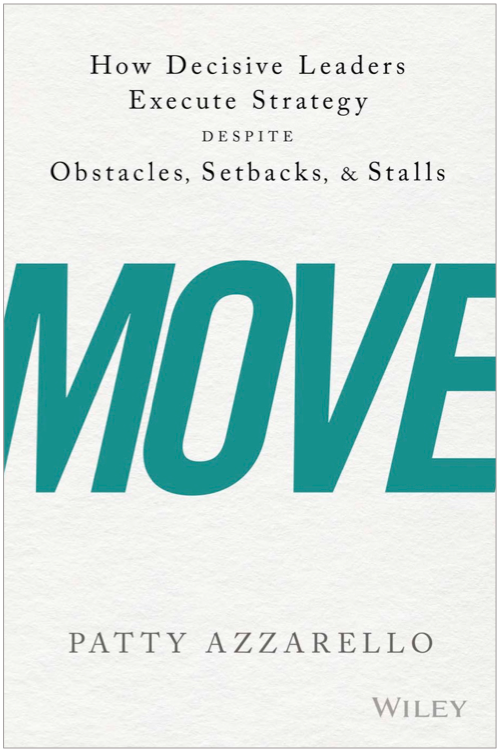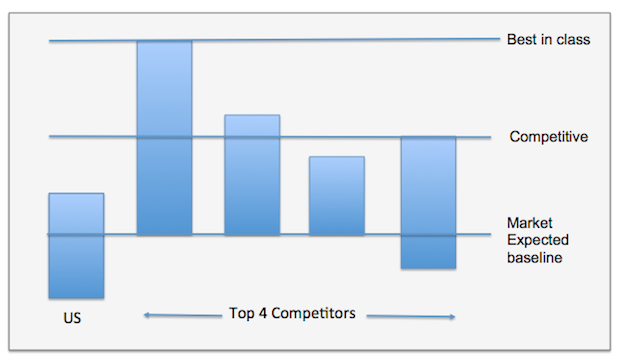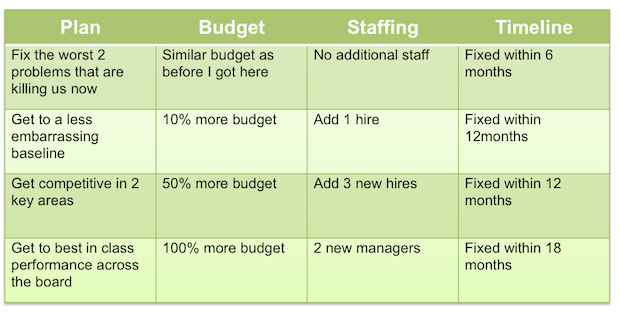
Awhile back I wrote an article called the first 30 days about how to start a new job with the most credibility.
There is another important point I want to add.
Always show the cost
I see people setting themselves up for failure and credibility loss when they don’t differentiate the cost of doing a great job from the cost of doing an OK job.
Here’s what I mean.
When you interview, your conversation is all about proving you know how to do a great job.
So you’ll say, here is how I would improve the [quality, competitiveness, customer satisfaction, marketing effectiveness, service, sales performance], etc.
You know how to do “great”, but…
You have told the story about how you can get this company to best in class for their industry. You are the expert. You know how to do it. You can do it.
They hire you based on your compelling tale of getting them to greatness, but then 3 things happen.
1. They expect you to deliver what you talked about
2. They underestimate how far behind they currently are
2. They don’t give you the budget to do it
It’s vitally important that within the first moments on your new job, in addition to creating the two lists I talked about in the prior article, you create 2 more things.
1. First create a visual representation of where your company truly is relative to best in class. (The size of the hole.)
2. Create a staggered realistic budget and timeline.
Climbing out of the hole
They hired you because they need your help.
One of the reasons they are in the hole that they are in is because they don’t fully understand why or even that they are in a hole. They know they are not performing, but because they do not have your expertise, they can’t see the 37 reasons why.
If you don’t show them the depth of the hole they are in, they will expect to get to best in class right away just because you showed up.
If you don’t show them the reality, there is a good chance they will believe that only thing between where they are now and best in class performance is you, with no additional staff, budget or time to get there.
Don’t let this happen. Act right away.
So you need to show the path and scope of the journey, and you need to show the budget.
1. First show the scope of the journey
Create something that looks kind of like this. The left axis is whatever it takes to be competitive in your space.
2. Next, show the true cost of winning…
Then you need to give the management choices for different levels of outcomes that cost different amounts.
OK, if you only increase my budget 10% we can fix these things, and add one item, but we can’t add most of the competitive features. If that’s the funding choice you make, this is what you will get.
The chart looks something like this:
This way you are still building credibility by showing that you can do the complete job, but you are not shooting yourself in the foot by signing up for the impossible.
The impossible is stressful!
I see leaders all the time that get signed up for doing the great job, but without the budget.
Then they put all the pressure on themselves to try to do the impossible without the necessary resources, and feel like they are personally failing when it can’t be done.
This is not your problem alone.
This is a choice that the company needs to make.
Your job is to shine the spotlight on clearly defined choices.
Do yourself a favor and make sure you paint the reality clearly as soon as you can, and only sign up for as much as you can get funded.
Share the knowledge of the scope of the journey.
Share the decision about the level of investment and expected outcomes with the management team. It’s not just you who should feel the pressure.
Make sure everyone has the same definition of success.
What do you think?
Join the conversation about this on my facebook page.
Was this useful?
If you found this article useful, please help me share it with others and encourage them to subscribe to this Blog for free.
Patty Azzarello is an executive, best-selling author, speaker and CEO/Business Advisor. She became the youngest general manager at HP at the age of 33, ran a billion dollar software business at 35 and became a CEO for the first time at 38 (all without turning into a self-centered, miserable jerk)
You can find Patty at www.AzzarelloGroup.com, follow her on twitter or facebook, or read her book RISE…3 Practical Steps for Advancing Your Career, Standing Out as a Leader, AND Liking Your Life.






